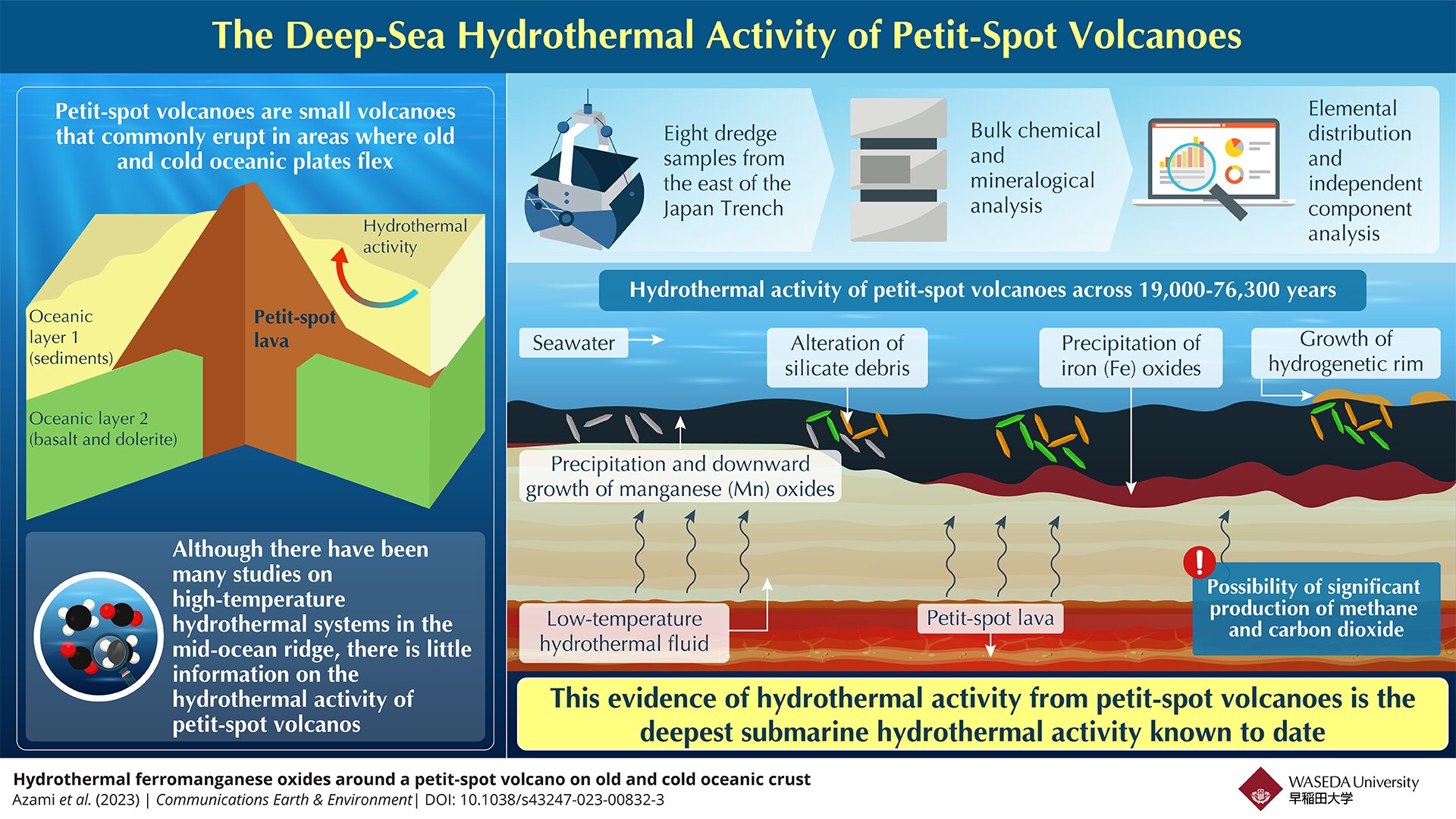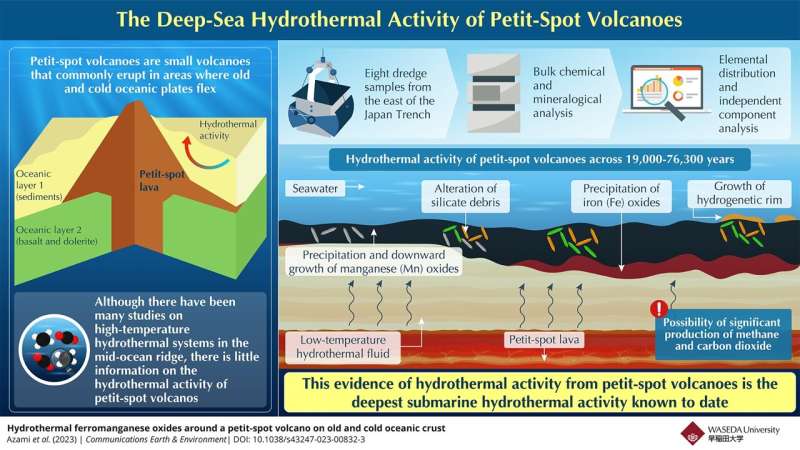

Underwater volcanoes on the Earth’s crust are active contributors of many different elements to the oceanic environment. Hence, they play an important role in biogeochemical and chemosynthetic cycles of the ocean. Although there have been many studies on high-temperature hydrothermal systems in the mid-ocean ridge—a series of underwater volcanoes that trace the edges of the different oceanic plates—there is little information on low-temperature hydrothermal systems in other volcanoes, such as “petit-spot” volcanoes.
Petit-spot volcanoes are small volcanoes that are found around the world, in regions where oceanic plates flex. Recent studies in the east of the Japan Trench have found that petit-spot volcanoes erupt alkaline magma that is enriched in carbon dioxide (CO2). These volcanoes also produce a volcanic rock called peperite that results from the heating of water-rich sediment, which implies hydrothermal fluid production and methanogenesis.
Thereby, it is suggested that petit-spot volcanoes may vent hydrothermal fluids containing methane. These findings indicate the need for a better understanding of the hydrothermal activity of petit-spot volcanoes to properly evaluate their contributions to marine biogeochemical cycle.
In a recent study, a team of scientists, including Assistant Professor Keishiro Azami from Waseda University, investigated hydrothermal deposits from a petit-spot volcano at a water depth of 5.7 km in the Japan Trench in the western North Pacific Ocean.
“The submarine hydrothermal activity we have described in our paper is the deepest known to date. Based on our findings, we have further estimated the hydrothermal interactions that occur in petit-spot volcanoes,” explains Azami. The research team also included Dr. Shiki Machida from Chiba Institution of Technology and Associate Professor Naoto Hirano from Tohoku University. The paper has been published in Communications Earth & Environment.
As a part of their study, the team analyzed the chemical and mineralogical composition of dredge samples obtained from the oceanic floor near the petit-spot volcano. They found that the samples were primarily composed of iron (Fe) and manganese (Mn) oxides, and that their characteristics were attributed to hydrothermal origin, i.e., the Fe–Mn oxides precipitated directly from hydrothermal fluid.
These results indicate petit-spot hydrothermal activity as the reason for the formation of these oxides and the petit-spot volcano as the deepest hydrothermal site known to date. The researchers also found that the chemical and mineral compositions of the samples were indicative of low-temperature hydrothermal activity.
The researchers then performed X-ray fluorescence spectroscopy to identify the elemental distribution of the sample cross-sections and performed independent component analysis on the elemental distribution data to elucidate the formation process of these Fe–Mn oxides. Their findings suggested that the formation of these Fe–Mn oxides starts when petit-spot magma produces low-temperature hydrothermal fluid, which flows up via the sediment column and precipitates Mn oxides at the interface with seawater.
This Mn oxide layer, which contains silicate debris, then grows downwards toward the seabed as more Mn oxide is deposited. Eventually this debris is altered. Next, Fe oxides are deposited via the same action on the interface between the low-temperature hydrothermal fluid and the Mn oxides. A hydrogenetic rim then grows on these deposits at the surface that is exposed to seawater, after the cessation of hydrothermal activity.
“Based on previous research, we can estimate hydrothermal fluid from petit-spot volcanoes to be enriched in CO2 and methane compared to that from the mid-ocean ridge,” explains Azami. “This means, in turn, that the elemental contributions from petit-spot hydrothermal activity around the world may potentially have important implications for global biogeochemical cycles, in particular the carbon cycle.”
These findings underscore the presence of hydrothermal activity in cold and old oceanic plates and highlight the need for further studies on petit-spot volcanoes.
More information:
Keishiro Azami et al, Hydrothermal ferromanganese oxides around a petit-spot volcano on old and cold oceanic crust, Communications Earth & Environment (2023). DOI: 10.1038/s43247-023-00832-3
Provided by
Waseda University
Citation:
Petit-spot volcanoes involve deepest known submarine hydrothermal activity, may release methane (2023, June 1)
retrieved 1 June 2023
from https://phys.org/news/2023-05-petit-spot-volcanoes-involve-deepest-submarine.html
This document is subject to copyright. Apart from any fair dealing for the purpose of private study or research, no
part may be reproduced without the written permission. The content is provided for information purposes only.